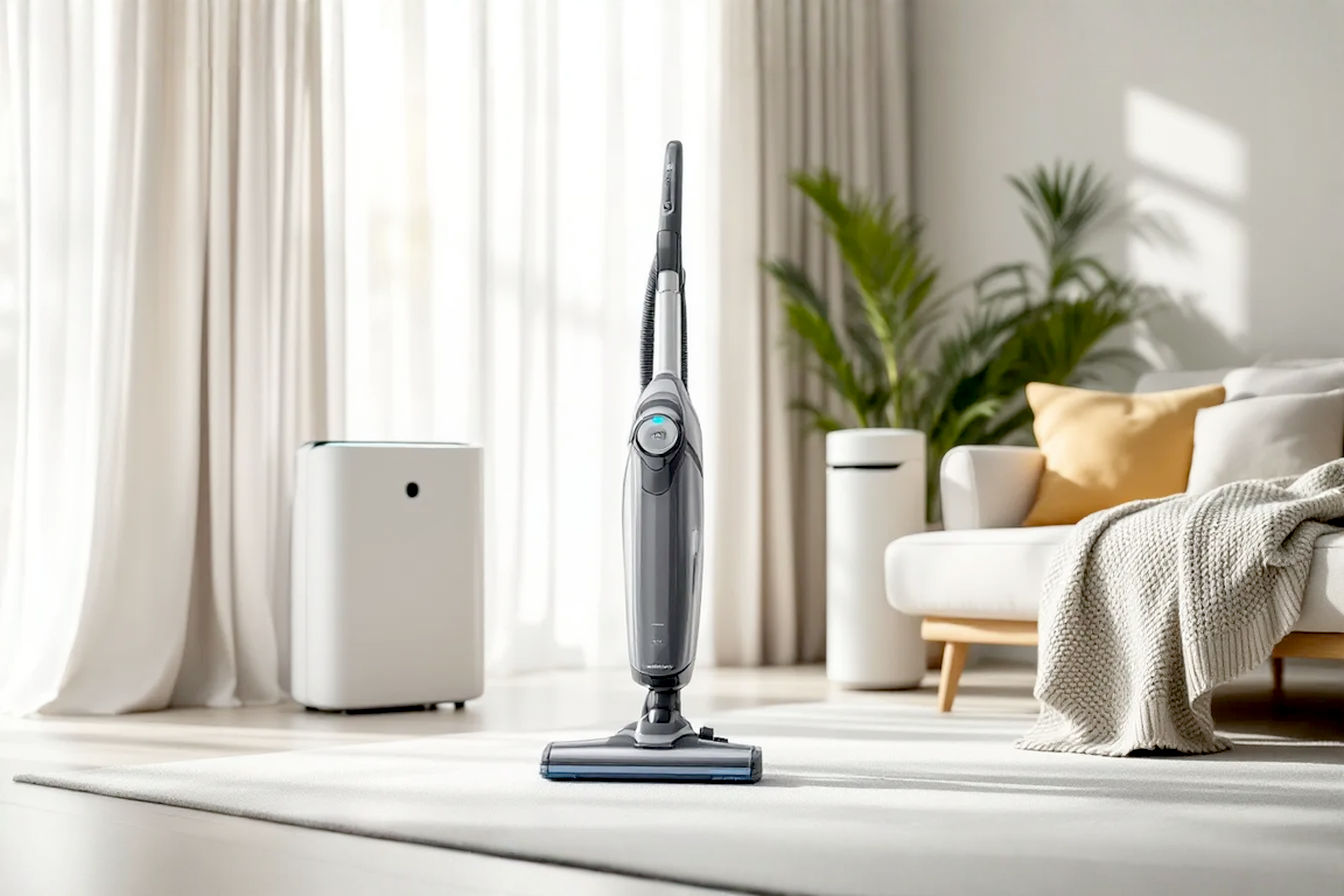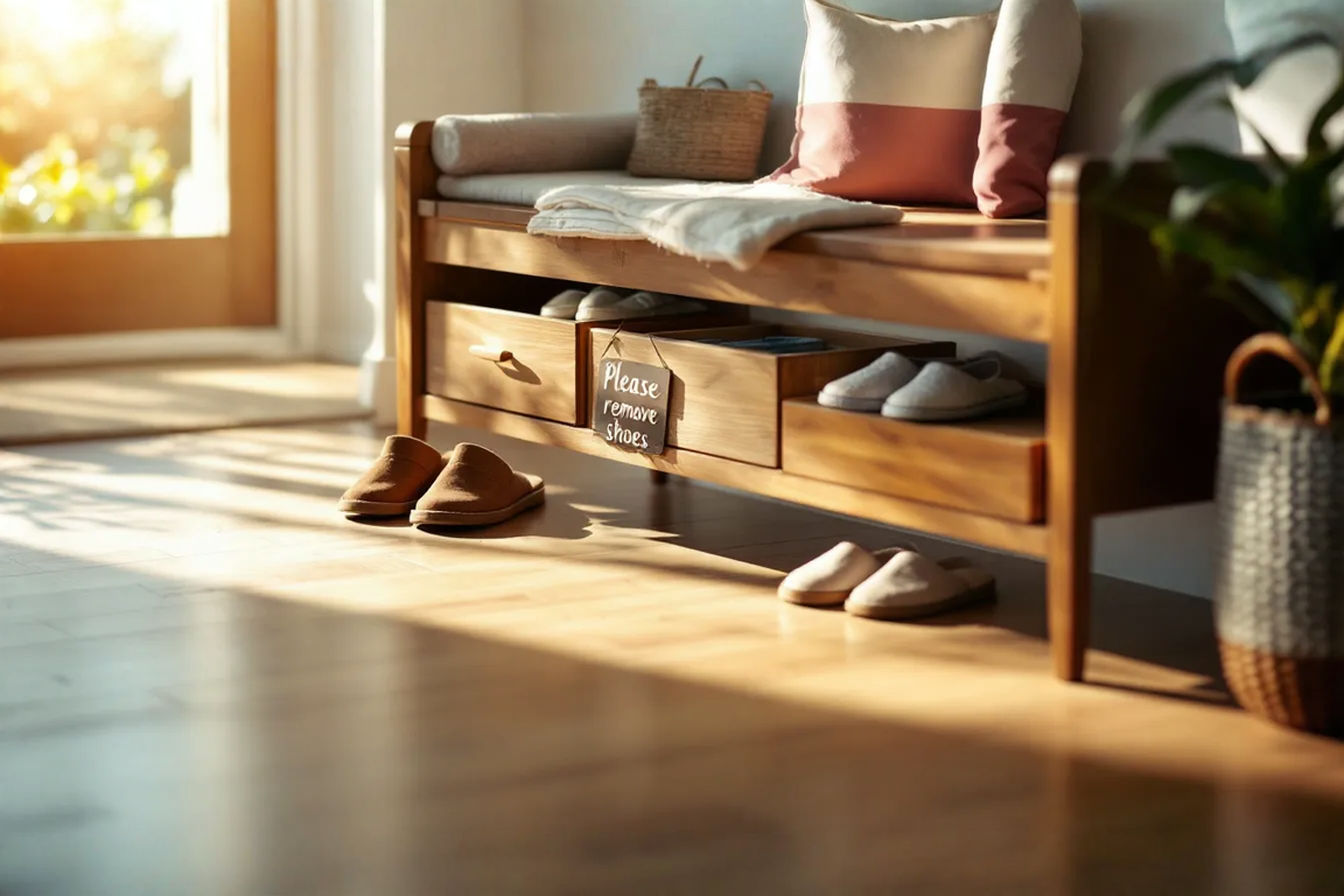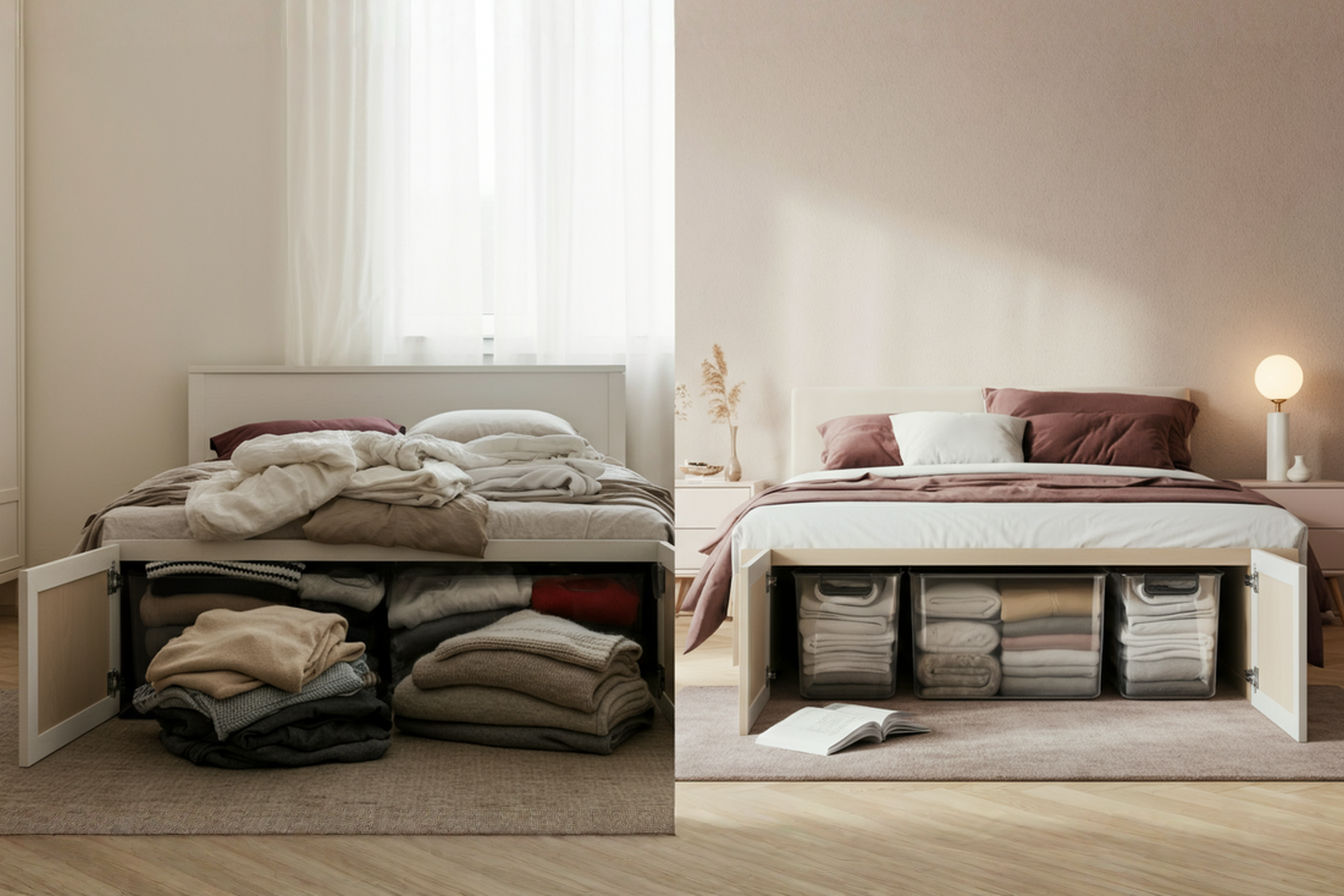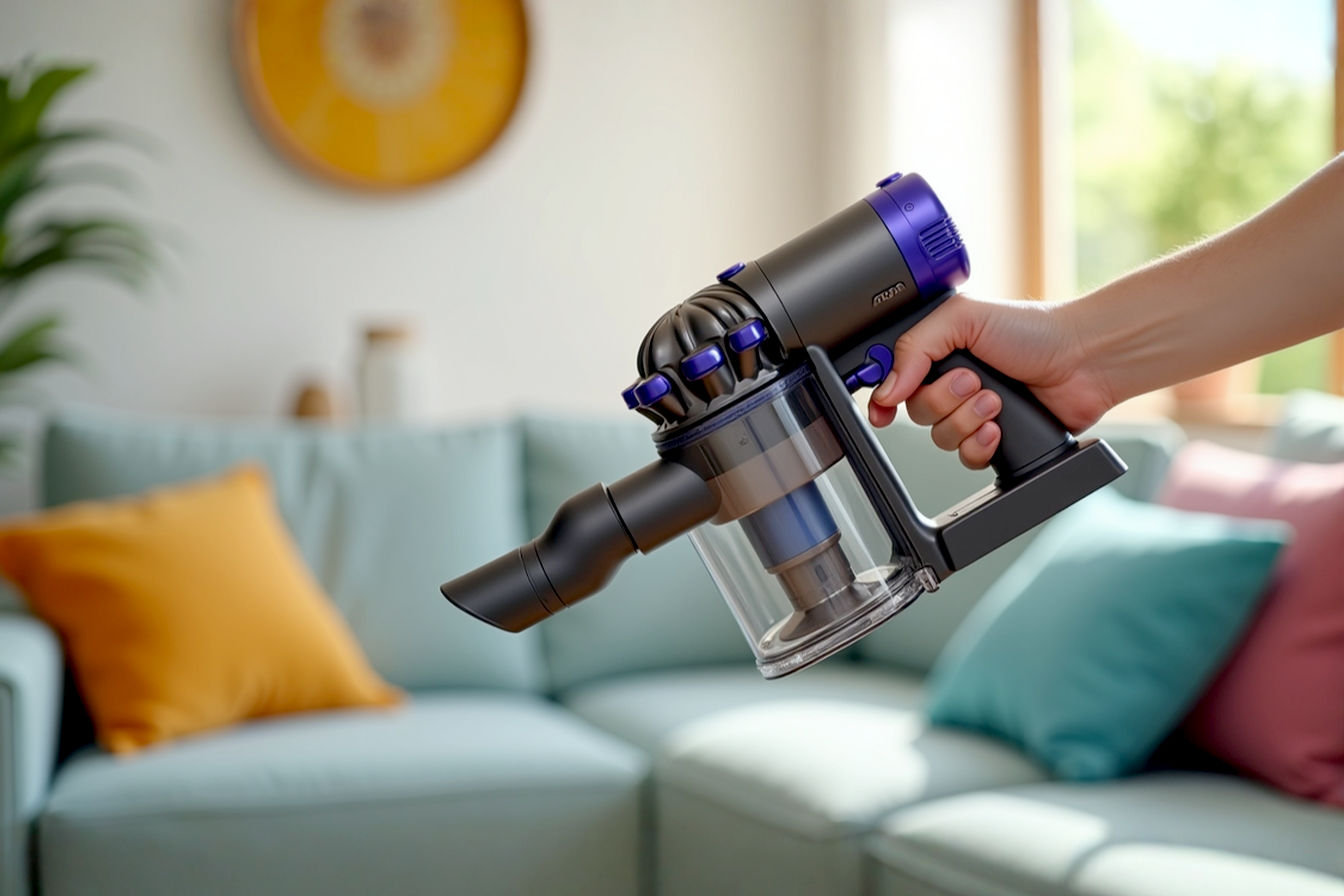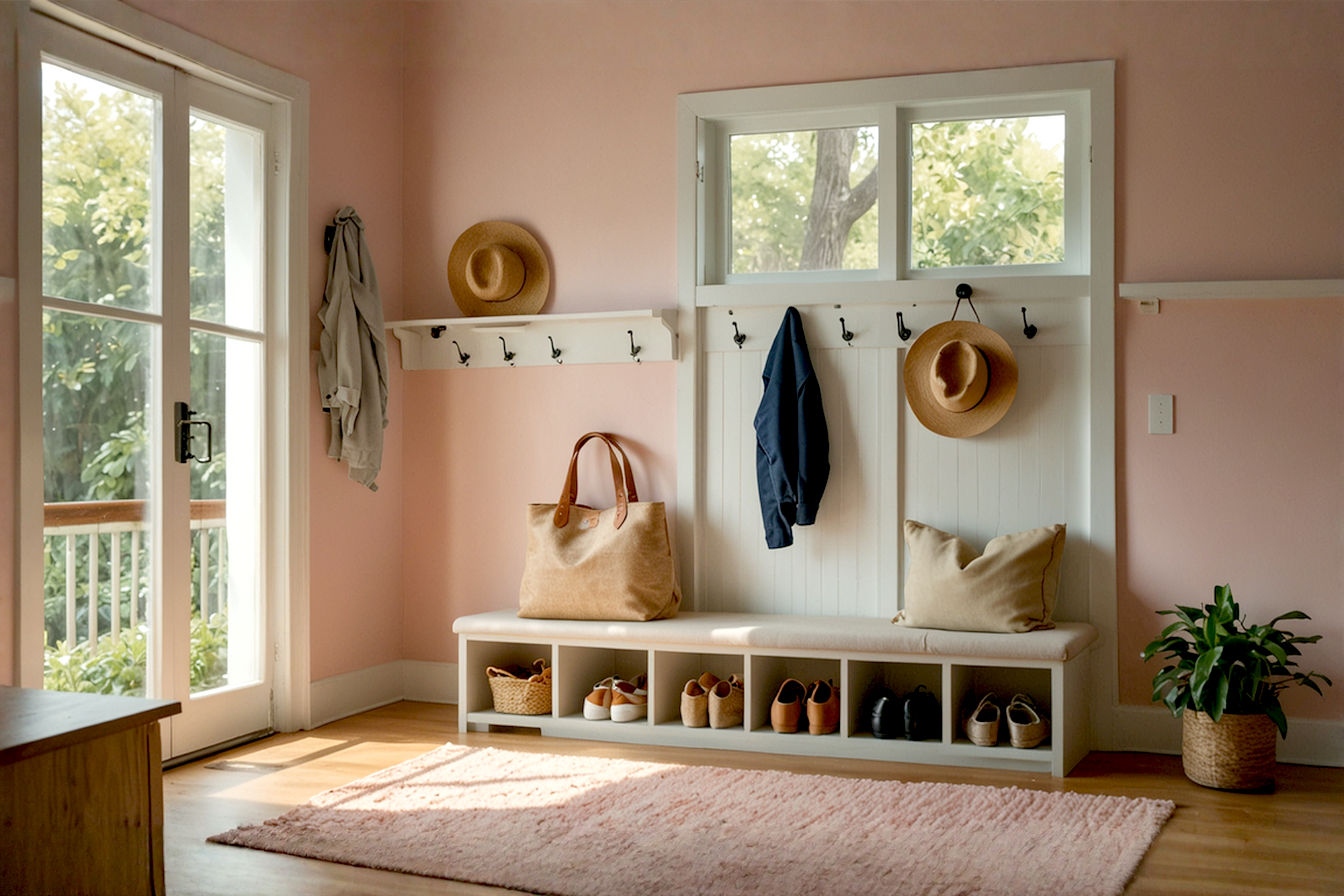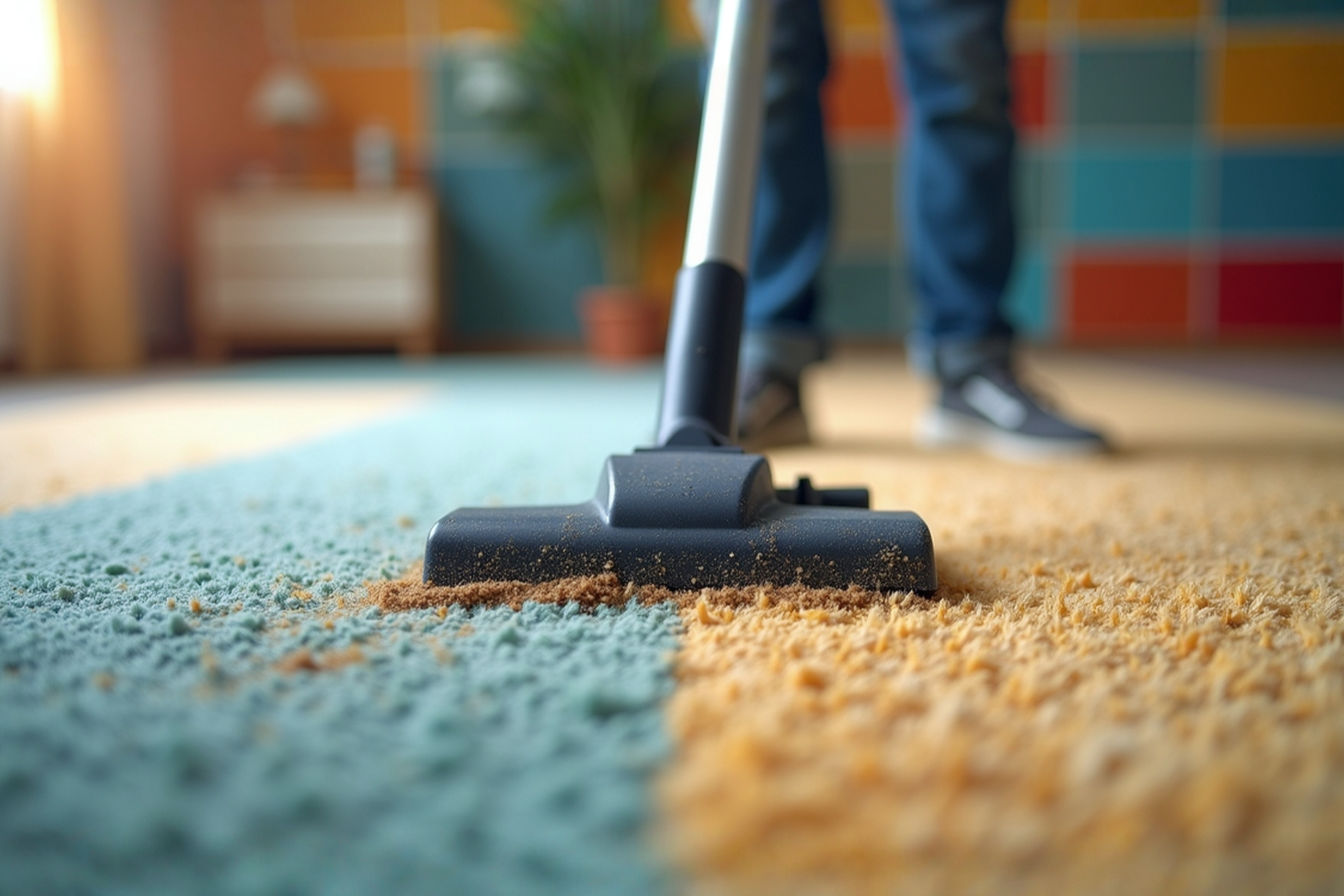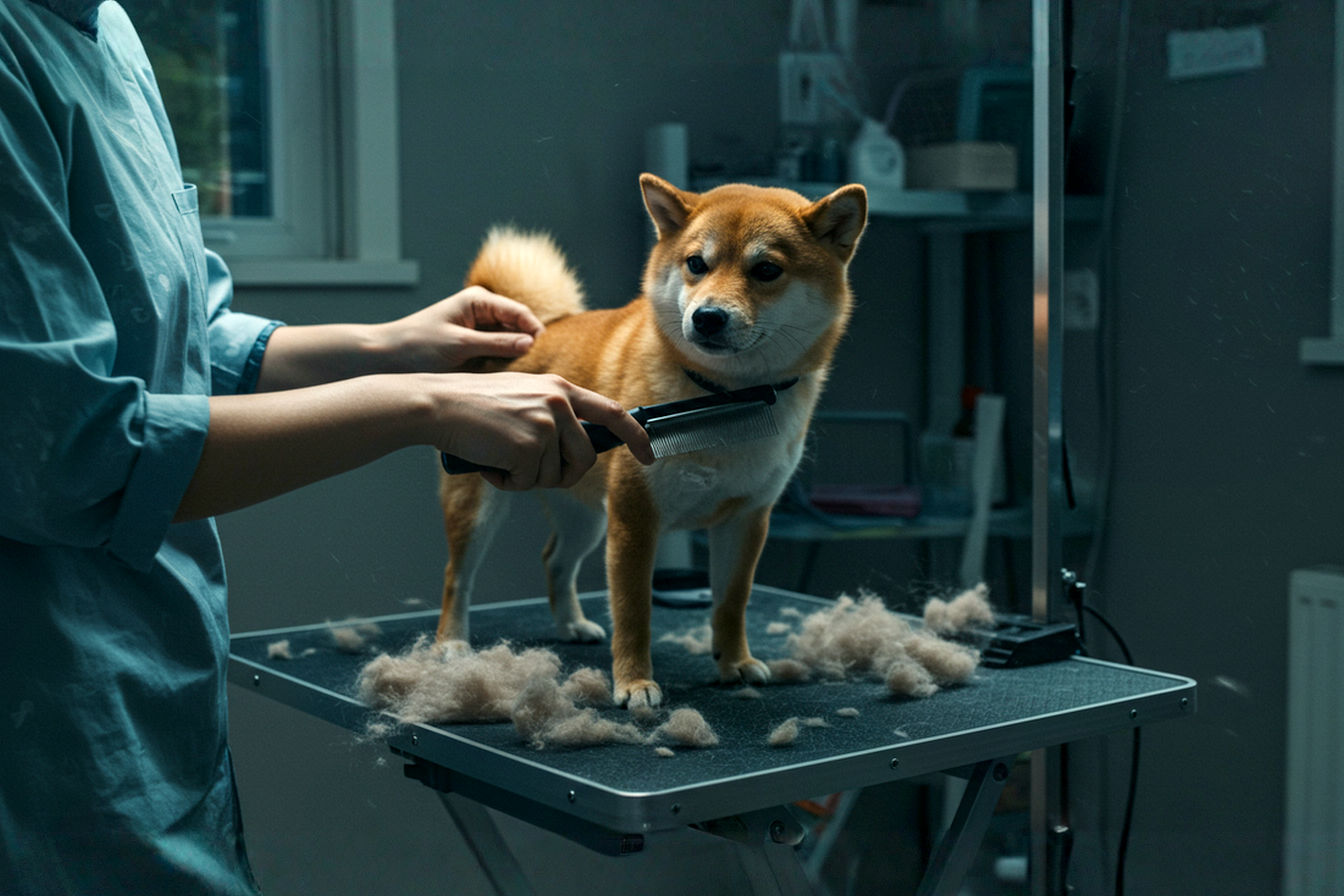Air Purification Coordination: Supporting Your Vacuum’s Allergen Control Efforts
Learn how to synchronize your vacuum cleaner and air purifier for maximum allergen control. This comprehensive guide reveals the strategies professionals use for cleaner, healthier home air.
This post may contain affiliate links. If you make a purchase through these links, we may earn a commission at no additional cost to you.
The battle against indoor allergens requires a coordinated approach that many homeowners overlook. While vacuuming regularly forms the foundation of most cleaning routines, it’s only part of a comprehensive allergen control strategy. Air purifiers and vacuum cleaners work as complementary systems, each addressing different aspects of the same problem. When these devices operate in harmony, they create a more effective defense against the invisible particles that trigger allergies and respiratory issues.
This guide explores how to coordinate your air purification and vacuuming efforts to maximize allergen removal throughout your home. We’ll examine how these systems work together, the technologies that power them, and practical strategies to enhance your indoor air quality through thoughtful integration. Whether you’re dealing with pet allergies, seasonal pollen, or general dust sensitivities, understanding this coordinated approach can dramatically improve your home environment.
Understanding the Allergen Challenge
Before diving into solutions, it’s crucial to understand what we’re fighting against. Household allergens come in various forms and sizes, each with unique characteristics that influence how we should approach their removal.
Common household allergens include:
- Dust mites: These microscopic creatures thrive in bedding, upholstery, and carpeting, feeding on shed human skin cells. Their waste products and decomposing bodies become airborne easily and are potent allergens.
- Pet dander: Tiny, lightweight skin flakes shed by cats, dogs, and other furry animals can remain suspended in air for hours and stick to surfaces throughout your home.
- Pollen: During growing seasons, these plant reproductive particles enter through windows, doors, and on clothing, settling on surfaces but also circulating through air currents.
- Mold spores: These reproductive cells from fungi thrive in damp areas and can become airborne, spreading throughout your home.
- Insect debris: Cockroaches and other insects leave behind particles from their bodies and waste that trigger allergic reactions.
What makes allergen control challenging is the dual nature of these particles. They exist in two states within your home:
- Settled allergens: Particles that have landed on surfaces, embedded in carpets, furniture, and bedding
- Airborne allergens: Particles suspended in the air, often too small to see
This dual existence creates what experts call the “allergen cycle”—particles settle, get disturbed (through walking, sitting, or other activities), become airborne again, and eventually resettle elsewhere. A single-device approach can’t effectively break this cycle, which is why coordination between systems becomes essential.
The smallest allergen particles (measuring 0.1-1 microns) can remain suspended in air for hours or even days. For comparison, a human hair is approximately 50-70 microns thick—meaning many allergens are 50-700 times smaller than a single hair. This microscopic size allows them to bypass many basic filtration systems and penetrate deep into lung tissue when inhaled.
The Complementary Role of Vacuums and Air Purifiers
Vacuum cleaners and air purifiers tackle different parts of the allergen cycle, making them natural partners in comprehensive air quality management.
How Vacuums Address Settled Allergens
Vacuum cleaners focus primarily on removing particles that have settled onto surfaces. They create suction that pulls dust, dander, and debris from carpets, furniture, and flooring. Modern vacuum technology can capture particles as small as 0.3 microns when equipped with proper filtration systems.
The strengths of vacuum cleaners include:
- Direct removal of accumulated allergens from surfaces
- Ability to reach corners, crevices, and under furniture
- Mechanical agitation that dislodges embedded particles
- Immediate cleanup of visible dust and debris
However, vacuums have important limitations. Standard models without adequate filtration can actually worsen air quality by stirring up fine particles and redistributing them through exhaust air. Even the act of vacuuming temporarily increases airborne allergen levels as movement disturbs settled particles.
How Air Purifiers Tackle Airborne Particles
Air purifiers specialize in capturing particles suspended in your indoor air. They draw in air through a series of filters designed to trap progressively smaller particles before releasing cleaned air back into the room. High-quality air purifiers can remove up to 99.97% of airborne particles as small as 0.3 microns.
The advantages of air purifiers include:
- Continuous filtration of airborne allergens 24/7
- Ability to capture particles too small for the human eye to see
- Reduction of odors and some volatile organic compounds (VOCs)
- Operation without physical interaction with contaminated surfaces
Their limitation is their inability to remove allergens already settled onto surfaces—they only process what’s currently in the air.
The Coverage Gap
Using only one system creates what experts call a “coverage gap” in your allergen control strategy:
- Vacuum-only approach: Leaves airborne particles untouched, allowing them to resettle and continue the allergen cycle
- Air purifier-only approach: Doesn’t address the reservoir of allergens in carpets, bedding, and furniture that continuously shed particles into the air
By coordinating both systems, you create a more complete approach that addresses both settled and airborne allergens, effectively breaking the cycle of recirculation.
HEPA Filtration: The Common Technology
At the heart of both effective vacuum cleaners and air purifiers lies HEPA (High-Efficiency Particulate Air) filtration technology. Understanding how this technology works in different applications helps explain why coordination between devices matters.
What HEPA Filtration Actually Means
HEPA isn’t just a marketing term—it’s a defined standard with specific performance requirements. True HEPA filters must capture at least 99.97% of particles as small as 0.3 microns in diameter. This specific size (0.3 microns) isn’t arbitrary; it represents what engineers call the “most penetrating particle size” (MPPS)—particles that are hardest to filter because they’re too large to be captured by diffusion and too small to be trapped by interception.
The filtration occurs through multiple physical mechanisms:
- Interception: Larger particles follow air streamlines but stick to filter fibers when they come into contact
- Impaction: Heavier particles collide with fibers when they can’t follow curved air streams
- Diffusion: Smaller particles move erratically due to Brownian motion, increasing chances of capture
- Electrostatic attraction: Some HEPA materials develop static charges that draw particles to the filter
How HEPA Works in Vacuums vs. Air Purifiers
While both devices may use HEPA filtration, their implementation differs significantly:
In vacuum cleaners, HEPA filtration serves as the final stage in a multi-stage system. Air carrying dust and debris first passes through a collection chamber or bag, then through one or more pre-filters before reaching the HEPA filter. This arrangement protects the HEPA material from larger particles that would quickly clog it. Vacuum HEPA filters typically handle high-velocity, dirt-laden air for short durations during cleaning sessions.
In air purifiers, HEPA filtration is often the primary filtration mechanism. The device typically includes a pre-filter to catch larger particles like hair and visible dust, followed by the HEPA filter that does most of the work. Some models add activated carbon filters for odor control or UV-C light for microbial neutralization. Air purifier HEPA filters process cleaner air at lower, steadier velocities continuously over extended periods.
Differences in Application and Implementation
These different operating environments lead to important distinctions:
- Vacuum HEPA systems face greater strain from heavier particle loads and must maintain filtration during pressure changes as the vacuum moves across different surfaces
- Air purifier HEPA systems operate in more controlled conditions but must maintain efficiency over much longer continuous run times
This difference explains why coordinating the two systems matters—they complement each other’s operational strengths while compensating for their respective limitations.
Creating an Effective Coordination Strategy
Maximizing allergen control requires thoughtful coordination between your vacuum and air purification systems. This coordination involves strategic device placement, careful scheduling, and adapting your approach to different spaces in your home.
Optimal Device Placement Throughout the Home
Where you position your air purifier significantly impacts its effectiveness:
- Place air purifiers in high-use areas like living rooms, bedrooms, and home offices where you spend most of your time
- Maintain proper clearance around air purifiers (typically 1-2 feet on all sides) to ensure optimal air circulation
- Consider room size and purifier capacity when determining placement—most manufacturers specify the maximum square footage their units can effectively clean
- Position air purifiers away from corners where air circulation is limited
- Keep air purifiers elevated (1-3 feet off the ground) in rooms where allergens like dust tend to remain airborne
For vacuum storage, accessibility matters more than location, but keeping your vacuum in a centralized, easy-to-access spot encourages more frequent use.
Scheduling and Sequencing Cleaning Activities
The order and timing of cleaning activities significantly impact overall effectiveness:
Optimal sequence for routine cleaning:
- Dust surfaces first using microfiber cloths that capture particles rather than dispersing them
- Vacuum thoroughly to remove settled particles disturbed by dusting
- Run air purifiers on high setting for 1-2 hours after vacuuming to capture newly airborne particles
- Return air purifiers to normal operating speed for continuous filtration
For deeper cleaning sessions:
- Remove and wash bedding, curtains, and washable items
- Dust from top to bottom throughout the space
- Vacuum all surfaces including furniture upholstery
- Clean hard surfaces with damp microfiber cloths
- Run air purifiers on high setting for 2-4 hours afterward
- Replace clean linens and bedding
Timing considerations:
- Vacuum high-traffic areas twice weekly to prevent allergen buildup
- Run air purifiers continuously in bedrooms and living spaces
- Increase air purifier fan speed temporarily during activities that create airborne particles (cooking, exercising, cleaning)
- Schedule deeper cleaning when pollen counts are lower (typically evenings for outdoor pollen)
Addressing Room-Specific Allergen Challenges
Different rooms face unique allergen challenges requiring tailored approaches:
Bedrooms:
- Use allergen-proof mattress and pillow covers
- Vacuum the mattress surface quarterly
- Run air purifiers continuously, especially while sleeping
- Wash bedding weekly in hot water (130°F/54°C minimum)
Living Rooms:
- Focus vacuum efforts on upholstered furniture and high-traffic carpet areas
- Position air purifiers near seating areas where movement frequently disturbs settled allergens
- Consider air purifiers with larger room coverage for these typically larger spaces
Kitchens:
- Use air purifiers with activated carbon filters to address cooking odors and particulates
- Vacuum frequently around dining areas where food particles accumulate
- Clean or replace range hood filters regularly
Bathrooms:
- Address humidity with proper ventilation to prevent mold growth
- Use air purifiers with antimicrobial features if moisture is a persistent issue
- Vacuum fan vents and air intakes to prevent dust buildup
By tailoring your approach to each space’s specific challenges, you create a more effective whole-home strategy.
Technology Matching for Maximum Effectiveness
Not all vacuums and air purifiers are created equal. Matching appropriate technologies ensures your systems complement each other effectively.
Pairing Appropriate Vacuum Types with Air Purifier Technologies
For homes with primarily hard flooring:
- Vacuum type: Canister vacuums with adjustable suction or stick vacuums with HEPA filtration
- Air purifier match: HEPA air purifiers with lower CADR (Clean Air Delivery Rate) as hard floors release fewer airborne particles during cleaning
For homes with extensive carpeting:
- Vacuum type: Upright vacuums with powered brush rolls and sealed HEPA systems
- Air purifier match: High-CADR HEPA air purifiers that can handle the heavier particle load generated during carpet cleaning
For homes with pets:
- Vacuum type: Vacuums specifically designed for pet hair with specialized attachments
- Air purifier match: HEPA purifiers with activated carbon filters to address both dander and pet odors
For allergy sufferers:
- Vacuum type: Fully-sealed HEPA vacuum systems with bagged collection (rather than bagless)
- Air purifier match: Medical-grade HEPA purifiers with multiple filtration stages
Considering Filtration Levels and Particle Size Capabilities
When matching systems, pay attention to filtration specifications:
- Standard vacuums typically capture particles down to 10-20 microns
- HEPA vacuums capture 99.97% of particles at 0.3 microns
- Basic air purifiers with HEPA-type filters capture 99% of particles at 2 microns
- True HEPA air purifiers capture 99.97% of particles at 0.3 microns
- Medical-grade purifiers may capture particles down to 0.1 microns
Ideally, your vacuum and air purifier should have similar filtration capabilities. If budget constraints force a choice, prioritize HEPA filtration in your air purifier while seeking the best filtration your budget allows in your vacuum.
Smart Device Integration Possibilities
Modern smart vacuums and air purifiers offer integration possibilities that enhance coordination:
- Air quality sensors in purifiers can increase filtration speed automatically when vacuuming activities are detected
- Scheduled routines through smart home systems can coordinate cleaning cycles
- Mobile app integration can provide data on air quality improvements after vacuuming
- Voice assistant compatibility allows for convenient operation of both systems
Smart features particularly worth considering include:
- Air purifiers that adjust automatically based on detected particle levels
- Robot vacuums that can be scheduled to run when you’re away, followed by programmed air purifier boost cycles
- Systems that generate reports on air quality trends over time, helping you refine your cleaning schedule
Implementation for Different Allergen Types
Different allergens require tailored approaches for effective removal and control.
Solutions for Pet Dander and Hair
Pet allergens present unique challenges because they’re both visible (hair) and microscopic (dander proteins):
Vacuum strategy:
- Use vacuums with specialized pet hair attachments and stronger suction
- Focus on areas where pets rest frequently
- Vacuum upholstered furniture at least twice weekly
- Consider robot vacuums for daily maintenance between deep cleaning sessions
Air purifier strategy:
- Use purifiers with both HEPA filtration and activated carbon to address dander and odors
- Position units in rooms where pets spend most time
- Run purifiers continuously, increasing speed after pets have been active or groomed
- Consider purifiers with washable pre-filters that can capture pet hair before it reaches HEPA filters
Coordination approach:
- Brush pets outdoors regularly to reduce indoor shedding
- Vacuum after grooming sessions immediately
- Run air purifiers on high for 2-3 hours after vacuuming pet areas
- Establish pet-free zones (particularly bedrooms) where possible
Approaches for Dust Mites and Microscopic Allergens
Dust mites present different challenges as they primarily colonize bedding, carpets, and upholstery:
Vacuum strategy:
- Use vacuums with UV-C light attachments that can help neutralize dust mites
- Apply special dust mite powder treatments before vacuuming carpets quarterly
- Vacuum mattresses and box springs every 1-2 months
- Use hot water extraction (steam cleaning) for carpets seasonally
Air purifier strategy:
- Use HEPA purifiers with high CADR ratings
- Position units in bedrooms where dust mite concentrations tend to be highest
- Consider purifiers with antimicrobial pre-treatment on filters
- Run purifiers continuously in sleeping areas
Coordination approach:
- Wash bedding weekly in hot water (130°F/54°C minimum)
- Vacuum mattresses thoroughly before applying fresh bedding
- Maintain indoor humidity below 50% to discourage dust mite proliferation
- Run air purifiers on high setting after changing bedding
Seasonal Strategies for Pollen and Outdoor Allergens
Seasonal allergens require adapting your approach throughout the year:
Vacuum strategy during high pollen seasons:
- Increase vacuuming frequency, focusing on entryways
- Vacuum window sills and door frames where pollen accumulates
- Use HEPA-filtered vacuums exclusively during peak seasons
- Consider wet-cleaning methods for hard floors rather than sweeping
Air purifier strategy:
- Boost air purifier settings during peak pollen days
- Position additional portable units near entry points
- Replace air purifier filters more frequently during heavy pollen seasons
- Consider purifiers with washable pre-filters for high pollen loads
Coordination approach:
- Remove shoes at entryways to reduce pollen tracking
- Change and wash clothes worn outdoors during high pollen days
- Vacuum entryways daily during peak seasons
- Run air purifiers on high when returning home after outdoor activities
Maintenance and Performance Optimization
Proper maintenance ensures both systems continue working effectively together.
Filter Replacement Schedules and Coordination
Coordinating maintenance schedules improves overall system efficiency:
Vacuum maintenance:
- Check vacuum bags or dustbins after each use, replacing bags when 2/3 full
- Clean or replace primary vacuum filters every 3-6 months depending on usage
- Replace HEPA filters in vacuums annually (more frequently in homes with pets)
- Clean brush rolls weekly to remove hair and fiber tangles
Air purifier maintenance:
- Replace pre-filters every 30-90 days depending on visible accumulation
- Replace HEPA filters according to manufacturer recommendations (typically 6-12 months)
- Replace activated carbon filters every 3-6 months as odor removal decreases
- Clean external intake grates weekly to prevent restricted airflow
Coordinated approach:
- Stagger replacements of vacuum and air purifier HEPA filters by 3-6 months to maintain continuous high-efficiency filtration
- Replace both systems’ filters after major events like renovations or flood/fire remediation
- Keep backup filters on hand for both systems to avoid gaps in protection
- Document replacement dates in a shared maintenance calendar
Cleaning Practices for Both Systems
Regular cleaning of the cleaning equipment itself is essential:
For vacuums:
- Empty bagless vacuums outdoors or in a garage when possible
- Wipe down vacuum exteriors with microfiber cloths weekly
- Clean vacuum attachments in warm soapy water monthly
- Inspect and clean vacuum hoses quarterly
For air purifiers:
- Wipe external surfaces weekly to prevent dust buildup
- Vacuum intake grates with brush attachments when visible dust accumulates
- Clean washable pre-filters according to manufacturer instructions
- Inspect internal fan components annually when changing filters
Special considerations:
- When cleaning either device, run the other at high speed to capture any disturbed particles
- Clean both systems outdoors when possible to prevent recontamination
- Use damp cloths rather than dusters when cleaning device exteriors
Performance Monitoring and Adjustment
Regular monitoring helps optimize your coordinated approach:
Signs your vacuum needs attention:
- Reduced suction or pickup performance
- Unusual noise during operation
- Visible dust in exhaust air
- Odors during or after vacuuming
Signs your air purifier needs attention:
- Increased fan noise
- Reduced airflow from output vents
- Air quality indicators showing poor readings despite operation
- Unit cycling on high frequently if equipped with automatic mode
Adjustment strategies:
- Track filter replacement dates and correlate with perceived allergy symptoms
- Note seasonal changes requiring adjusted maintenance schedules
- Consider professional deep cleaning of carpets when home systems show diminishing returns
- Upgrade components based on identified weaknesses in your system
Advanced Coordination Techniques
For homeowners seeking maximum allergen control, advanced integration approaches offer additional benefits.
Whole-Home Air Purification Systems
Beyond portable units, whole-home systems offer comprehensive coverage:
HVAC-integrated purification:
- In-duct UV purification neutralizes microorganisms as air circulates
- Electronic air cleaners attach to existing HVAC systems, filtering all air passing through
- Media air cleaners provide whole-home HEPA or near-HEPA filtration
- HVAC filter upgrades from standard MERV 4-8 filters to MERV 11-13 improve allergen capture
These systems complement vacuuming by:
- Providing continuous whole-home filtration
- Reducing particle resettling after vacuuming
- Filtering air in areas difficult to vacuum frequently
Implementation considerations:
- Professional installation usually required
- Higher initial investment but potentially lower long-term operational costs
- Reduced maintenance compared to multiple portable units
- Quieter operation than portable units
Central Vacuum Integration Possibilities
Central vacuum systems offer significant advantages for coordinated allergen control:
Key benefits:
- Exhaust vented outside the living space, eliminating recirculation concerns
- More powerful suction than portable vacuums
- Quieter operation encouraging more frequent cleaning
- Multiple inlets throughout the home for convenient access
Coordination strategies with air purification:
- Pair with whole-home air purification for complete coverage
- Use central vacuum first, followed by running air purification systems
- Schedule automatic air purifier boost cycles after central vacuum use
Advanced central vacuum features:
- HEPA filtration options for exhaust air if venting outdoors isn’t possible
- Split-tank water filtration systems that trap particles in water
- Performance monitoring systems that alert to reduced suction or filter issues
Smart Home Automation for Air Quality
Emerging technologies enable sophisticated coordination through automation:
Air quality monitoring integration:
- Standalone sensors that detect particle levels, VOCs, CO2, and humidity
- Smart thermostats with built-in air quality monitoring
- Connected systems that track indoor vs. outdoor pollution levels
Automation possibilities:
- Air purifiers that activate automatically when vacuum use is detected
- Scheduled routines that coordinate cleaning cycles
- Systems that analyze air quality patterns and suggest optimal cleaning schedules
- Automatic adjustment of HVAC filtration based on measured particle levels
Implementation approaches:
- Start with a central smart home hub (SmartThings, Home Assistant, Apple HomeKit)
- Add compatible air quality sensors in key locations
- Integrate smart plugs for non-connected air purifiers
- Create automation routines that coordinate devices
Measuring Success: Air Quality Monitoring
Tracking improvements in air quality provides motivation and helps refine your approach.
Tools and Technologies for Tracking Improvement
Several options exist for measuring indoor air quality:
Consumer-grade air quality monitors:
- Particle counters that measure PM2.5 and PM10 levels
- VOC sensors that detect gaseous pollutants
- CO2 monitors that can indicate ventilation adequacy
- Multi-parameter devices that track multiple pollutant types
Professional testing options:
- Laboratory analysis of dust samples for allergen content
- Professional air quality assessments with calibrated equipment
- HVAC system performance testing and evaluation
- Biological sampling for mold spores or dust mite concentration
Practical monitoring approaches:
- Establish baseline readings before implementing coordination strategies
- Monitor air quality during and after vacuuming to assess immediate impact
- Track long-term trends across seasons and different weather conditions
- Compare readings in different rooms to identify problem areas
Setting Reasonable Expectations for Results
Understanding realistic outcomes helps evaluate system performance:
Typical improvements with coordinated systems:
- 50-80% reduction in airborne particle counts during normal conditions
- 70-90% reduction in settled dust accumulation over time
- Noticeable decrease in allergy symptoms for most sufferers
- Reduced need for dusting and surface cleaning
Timeframes for observable changes:
- Airborne particle reduction: Minutes to hours after implementation
- Surface dust accumulation reduction: 1-4 weeks of consistent implementation
- Allergy symptom improvement: 1-8 weeks depending on allergen type and sensitivity
- Complete stabilization of new baseline conditions: 2-3 months
Limitations to recognize:
- External factors like outdoor air quality will continue to influence results
- Seasonal variations will require system adjustments
- Some allergen sources (like pets) create ongoing challenges
- Complete elimination of all allergens isn’t realistic—significant reduction is the goal
Using Data to Refine Your Approach
Monitoring data should inform ongoing adjustments to your strategy:
Response-driven adjustments:
- If particle counts spike after vacuuming, consider vacuum filtration upgrades
- If bedroom air quality lags behind other rooms, increase purifier capacity or add additional units
- If seasonal allergies still breakthrough, implement targeted strategies during peak periods
- If specific activities create air quality issues, develop specific protocols for those times
Data-informed optimization:
- Track filter replacement impact on air quality measurements
- Compare effectiveness of different cleaning sequences
- Identify problem areas requiring additional attention
- Quantify improvement from system upgrades to evaluate cost-effectiveness
Cost-Benefit Analysis and Budget Planning
Implementing coordinated air quality management requires financial planning and prioritization.
Investment Considerations for Different Homes
The optimal investment varies based on several factors:
For apartments and smaller homes (under 1,000 sq ft):
- One high-quality HEPA vacuum: $200-400
- 1-2 room-sized air purifiers: $200-500 total
- Basic air quality monitor: $80-150
- Annual filter replacement costs: $100-200
- Approximate total first-year investment: $580-1,250
For medium-sized homes (1,000-2,500 sq ft):
- Quality HEPA vacuum with specialized attachments: $300-700
- 2-4 room-sized air purifiers or 1-2 larger units: $400-1,200
- Multi-parameter air quality monitor: $150-300
- Annual filter replacement costs: $200-400
- Approximate total first-year investment: $1,050-2,600
For larger homes (over 2,500 sq ft):
- Premium vacuum system or central vacuum installation: $800-3,000
- Whole-home air purification system or 4+ room units: $1,200-4,000
- Multi-room air quality monitoring: $300-700
- Annual maintenance and filter costs: $300-800
- Approximate total first-year investment: $2,600-8,500
Prioritizing Purchases for Maximum Impact
With limited budgets, strategic implementation maximizes results:
Step 1: Foundation (First purchases)
- Quality HEPA vacuum suitable for your flooring types
- Single air purifier for the bedroom (where you spend most time)
- Basic cleaning tools like microfiber cloths and allergen-proof covers
Step 2: Expansion (When additional funds available)
- Additional air purifiers for living spaces
- Vacuum upgrades or specialized attachments
- Basic air quality monitor
Step 3: Optimization (For comprehensive coverage)
- Whole-home solutions or additional room coverage
- Smart integration components
- Advanced monitoring systems
Highest ROI purchases:
- Allergen-proof mattress and pillow covers
- HEPA air purifier for the primary bedroom
- Quality vacuum with sealed HEPA filtration
- Washable microfiber cleaning tools
Long-Term Maintenance Costs and Considerations
Ongoing costs affect the total investment over time:
Annual maintenance expenses:
- Vacuum bags/filters: $30-100 annually
- Air purifier replacement filters: $60-300 annually depending on number of units
- HVAC filter replacements (if upgraded): $60-180 annually
- Power consumption: $20-150 annually depending on system types and usage
Lifespan considerations:
- Quality HEPA vacuums: 5-10 years
- Portable air purifiers: 3-7 years
- Whole-home systems: 10-15 years
- Central vacuum systems: 15-20 years
Cost-saving strategies:
- Bulk purchase replacement filters when on sale
- Extend pre-filter life through careful cleaning
- Maintain equipment regularly to prevent premature failure
- Consider washable/reusable components where available
Conclusion
Effective allergen control requires thinking beyond individual cleaning tools to create a coordinated system that addresses both airborne and settled particles. By understanding how vacuums and air purifiers complement each other, you can develop a comprehensive strategy that significantly improves your indoor air quality.
The most successful approaches combine:
- Appropriate technology selection based on your specific home environment and allergen concerns
- Strategic implementation that maximizes the effectiveness of each system
- Consistent maintenance to ensure ongoing performance
- Adaptive strategies that respond to seasonal changes and specific allergen challenges
As air quality technology continues to advance, we’re seeing promising trends toward more integrated systems that communicate with each other, automatically adjusting to changing conditions and providing real-time feedback. Smart home integration is making coordination increasingly seamless, with systems that can detect when vacuuming occurs and automatically boost air purification in response.
The key takeaway is that neither vacuuming nor air purification alone provides complete protection. The most effective approach is a thoughtfully coordinated strategy that leverages the strengths of both systems while minimizing their individual limitations. By implementing the techniques described in this guide, you can create a comprehensive allergen control system that makes a noticeable difference in your home’s air quality and your family’s well-being.
Begin with the foundational steps outlined here, monitor your results, and gradually refine your approach based on observed improvements. Your reward will be cleaner air, reduced allergen levels, and a healthier home environment.

